fuel FIAT TALENTO 2021 Owner handbook (in English)
[x] Cancel search | Manufacturer: FIAT, Model Year: 2021, Model line: TALENTO, Model: FIAT TALENTO 2021Pages: 236, PDF Size: 4.86 MB
Page 76 of 236
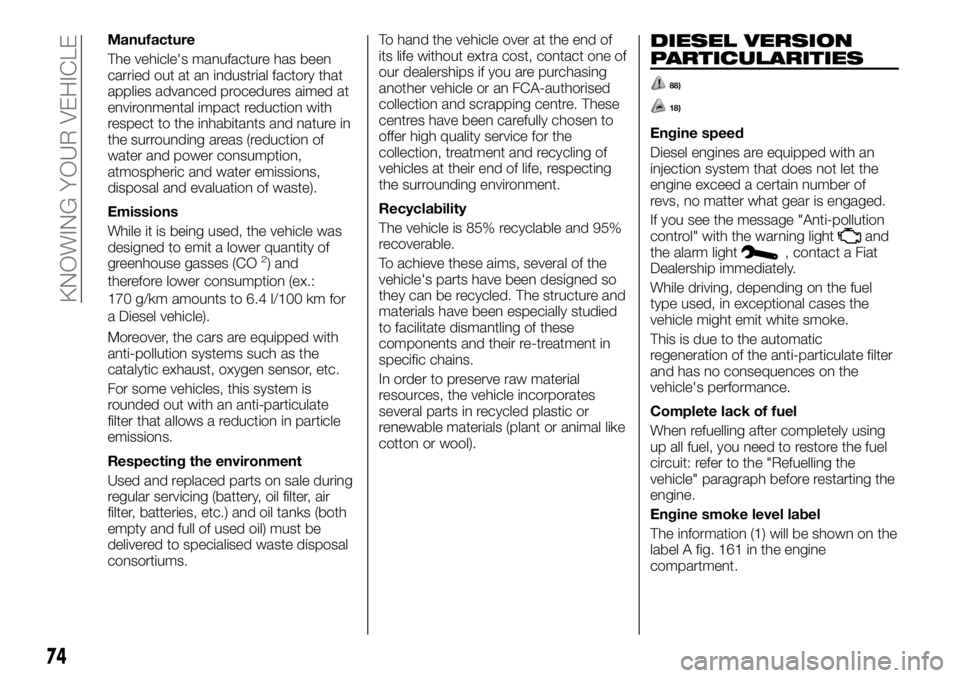
Manufacture
The vehicle's manufacture has been
carried out at an industrial factory that
applies advanced procedures aimed at
environmental impact reduction with
respect to the inhabitants and nature in
the surrounding areas (reduction of
water and power consumption,
atmospheric and water emissions,
disposal and evaluation of waste).
Emissions
While it is being used, the vehicle was
designed to emit a lower quantity of
greenhouse gasses (CO
2) and
therefore lower consumption (ex.:
170 g/km amounts to 6.4 l/100 km for
a Diesel vehicle).
Moreover, the cars are equipped with
anti-pollution systems such as the
catalytic exhaust, oxygen sensor, etc.
For some vehicles, this system is
rounded out with an anti-particulate
filter that allows a reduction in particle
emissions.
Respecting the environment
Used and replaced parts on sale during
regular servicing (battery, oil filter, air
filter, batteries, etc.) and oil tanks (both
empty and full of used oil) must be
delivered to specialised waste disposal
consortiums.To hand the vehicle over at the end of
its life without extra cost, contact one of
our dealerships if you are purchasing
another vehicle or an FCA-authorised
collection and scrapping centre. These
centres have been carefully chosen to
offer high quality service for the
collection, treatment and recycling of
vehicles at their end of life, respecting
the surrounding environment.
Recyclability
The vehicle is 85% recyclable and 95%
recoverable.
To achieve these aims, several of the
vehicle's parts have been designed so
they can be recycled. The structure and
materials have been especially studied
to facilitate dismantling of these
components and their re-treatment in
specific chains.
In order to preserve raw material
resources, the vehicle incorporates
several parts in recycled plastic or
renewable materials (plant or animal like
cotton or wool).
DIESEL VERSION
PARTICULARITIES
88)
18)
Engine speed
Diesel engines are equipped with an
injection system that does not let the
engine exceed a certain number of
revs, no matter what gear is engaged.
If you see the message "Anti-pollution
control" with the warning light
and
the alarm light, contact a Fiat
Dealership immediately.
While driving, depending on the fuel
type used, in exceptional cases the
vehicle might emit white smoke.
This is due to the automatic
regeneration of the anti-particulate filter
and has no consequences on the
vehicle's performance.
Complete lack of fuel
When refuelling after completely using
up all fuel, you need to restore the fuel
circuit: refer to the "Refuelling the
vehicle" paragraph before restarting the
engine.
Engine smoke level label
The information (1) will be shown on the
label A fig. 161 in the engine
compartment.
74
KNOWING YOUR VEHICLE
Page 79 of 236
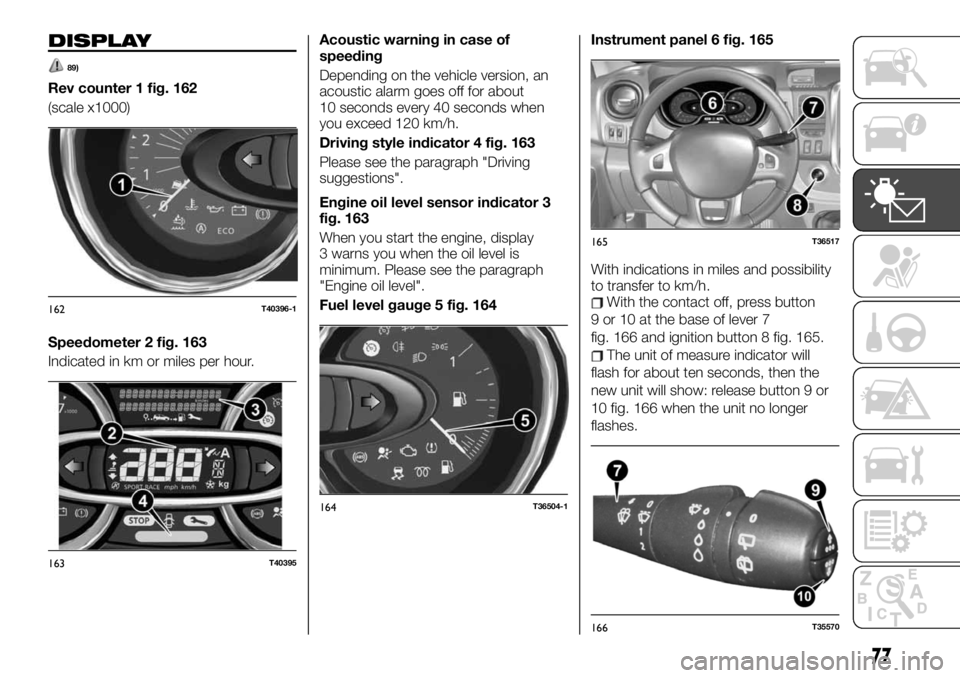
DISPLAY
89)
Rev counter 1 fig. 162
(scale x1000)
Speedometer 2 fig. 163
Indicated in km or miles per hour.Acoustic warning in case of
speeding
Depending on the vehicle version, an
acoustic alarm goes off for about
10 seconds every 40 seconds when
you exceed 120 km/h.
Driving style indicator 4 fig. 163
Please see the paragraph "Driving
suggestions".
Engine oil level sensor indicator 3
fig. 163
When you start the engine, display
3 warns you when the oil level is
minimum. Please see the paragraph
"Engine oil level".
Fuel level gauge 5 fig. 164Instrument panel 6 fig. 165
With indications in miles and possibility
to transfer to km/h.
With the contact off, press button
9 or 10 at the base of lever 7
fig. 166 and ignition button 8 fig. 165.
The unit of measure indicator will
flash for about ten seconds, then the
new unit will show: release button 9 or
10 fig. 166 when the unit no longer
flashes.
162T40396-1
163T40395
164T36504-1
165T36517
166T35570
77
Page 83 of 236
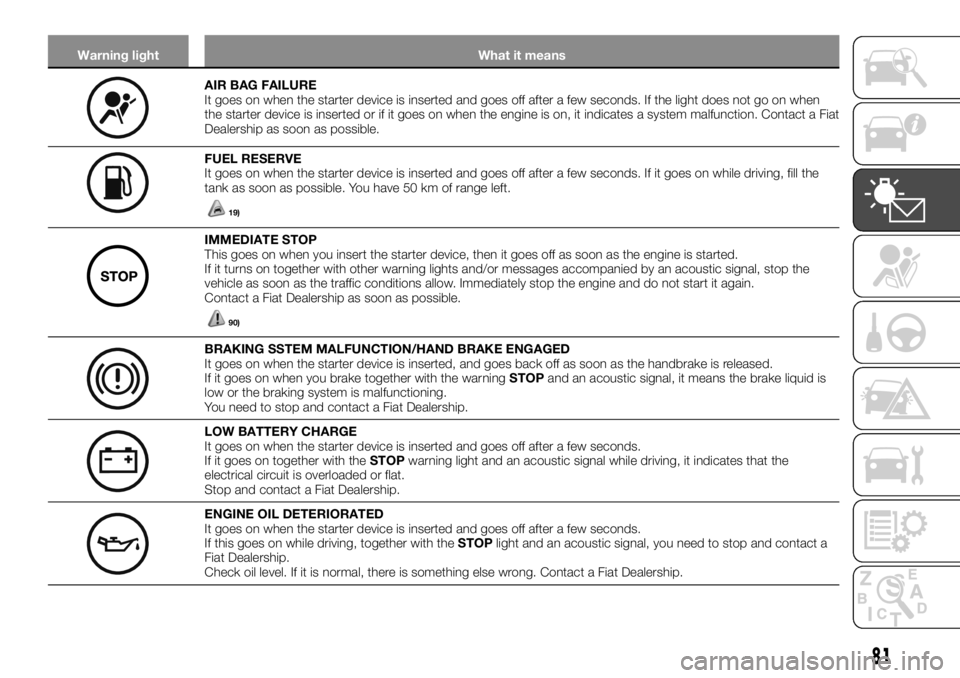
Warning light What it means
AIR BAG FAILURE
It goes on when the starter device is inserted and goes off after a few seconds. If the light does not go on when
the starter device is inserted or if it goes on when the engine is on, it indicates a system malfunction. Contact a Fiat
Dealership as soon as possible.
FUEL RESERVE
It goes on when the starter device is inserted and goes off after a few seconds. If it goes on while driving, fill the
tank as soon as possible. You have 50 km of range left.
19)
IMMEDIATE STOP
This goes on when you insert the starter device, then it goes off as soon as the engine is started.
If it turns on together with other warning lights and/or messages accompanied by an acoustic signal, stop the
vehicle as soon as the traffic conditions allow. Immediately stop the engine and do not start it again.
Contact a Fiat Dealership as soon as possible.
90)
BRAKING SSTEM MALFUNCTION/HAND BRAKE ENGAGED
It goes on when the starter device is inserted, and goes back off as soon as the handbrake is released.
If it goes on when you brake together with the warningSTOPand an acoustic signal, it means the brake liquid is
low or the braking system is malfunctioning.
You need to stop and contact a Fiat Dealership.
LOW BATTERY CHARGE
It goes on when the starter device is inserted and goes off after a few seconds.
If it goes on together with theSTOPwarning light and an acoustic signal while driving, it indicates that the
electrical circuit is overloaded or flat.
Stop and contact a Fiat Dealership.
ENGINE OIL DETERIORATED
It goes on when the starter device is inserted and goes off after a few seconds.
If this goes on while driving, together with theSTOPlight and an acoustic signal, you need to stop and contact a
Fiat Dealership.
Check oil level. If it is normal, there is something else wrong. Contact a Fiat Dealership.
81
Page 89 of 236

CONTROL PANEL
AND ON-BOARD
INSTRUMENTS
On-board computer 1 fig. 172
Depending on the vehicle version, it
includes the following functions:
distance travelled;
travel parameters;
information messages;
malfunction messages (together with
warning lights
);
alarm messages (together with the
STOPwarning light).
Selection buttons for displaying
Scroll up (button 9) or down (button 10)
for the following information, pressing a
few times briefly (the display will depend
on the vehicle's equipment and country
of sale) fig. 173.You can view the following information
on the display screen:
overall and partial odometer for the
distance travelled;
fuel consumed;
average fuel consumption;
instantaneous consumption;
expected range with remaining fuel;
distance travelled;
average speed;
service limit, oil change counter;
tyre pressure re-initialisation;
speed set on the Cruise Control /
Speed Limiter;
time and temperature;
on-board log, information message
scrolling and operational malfunction;
percentage volume of remaining
additive.Resetting the trip odometer
When the "trip meter" display is
selected, press either button 9 or 10
fig. 173 until the odometer is reset to
zero.
Resetting travel parameters
When one of the trip parameters is
selected on the display, press button
9 or 10 fig. 173 until the display is reset.
Interpreting some of the displayed
values after resetting
The further you travel after the last
reset, the more accurate and significant
the average fuel consumption,
autonomy and average speed become.
During the first kilometres travelled after
resetting, you will notice that the
autonomy increases as you travel. This
is because the system takes the
average fuel consumption since the last
reset into account. The average fuel
consumption can decrease when:
the vehicle is no longer accelerating;
the engine reaches operating
temperature (reset: cold engine);
going from urban to extra-urban
driving.
Automatic travel parameter reset
Reset is automatic when one of the
parameter's capacities is exceeded.
172T36518
173T35570
87
Page 90 of 236
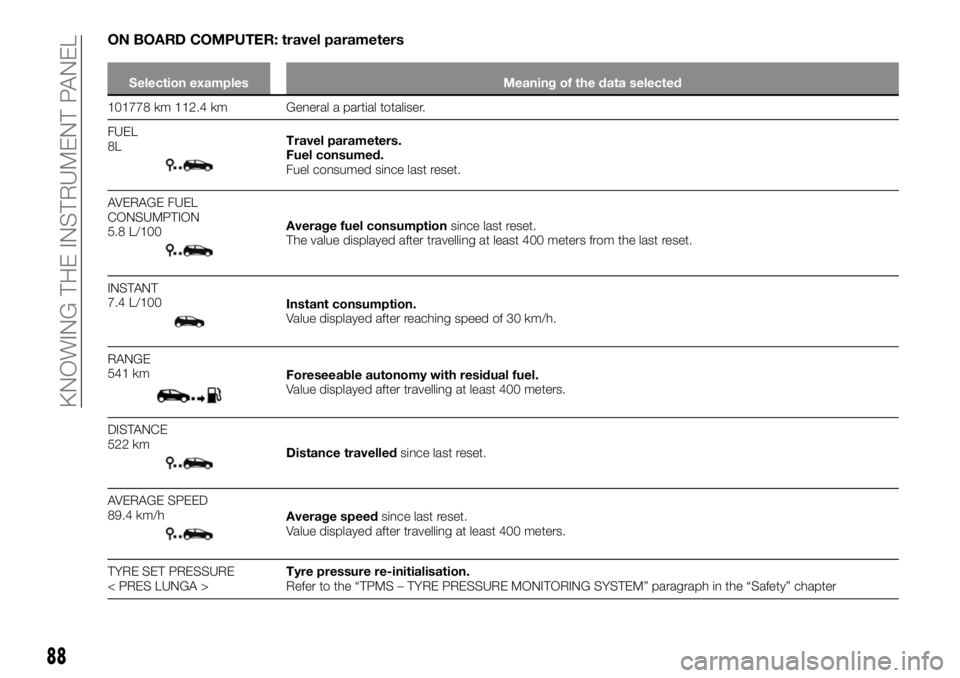
ON BOARD COMPUTER: travel parameters
Selection examples Meaning of the data selected
101778 km 112.4 km General a partial totaliser.
FUEL
8L
Travel parameters.
Fuel consumed.
Fuel consumed since last reset.
AVERAGE FUEL
CONSUMPTION
5.8 L/100
Average fuel consumptionsince last reset.
The value displayed after travelling at least 400 meters from the last reset.
INSTANT
7.4 L/100
Instant consumption.
Value displayed after reaching speed of 30 km/h.
RANGE
541 km
Foreseeable autonomy with residual fuel.
Value displayed after travelling at least 400 meters.
DISTANCE
522 km
Distance travelledsince last reset.
AVERAGE SPEED
89.4 km/h
Average speedsince last reset.
Value displayed after travelling at least 400 meters.
TYRE SET PRESSURE
< PRES LUNGA >Tyre pressure re-initialisation.
Refer to the “TPMS – TYRE PRESSURE MONITORING SYSTEM” paragraph in the “Safety” chapter
88
KNOWING THE INSTRUMENT PANEL
Page 135 of 236
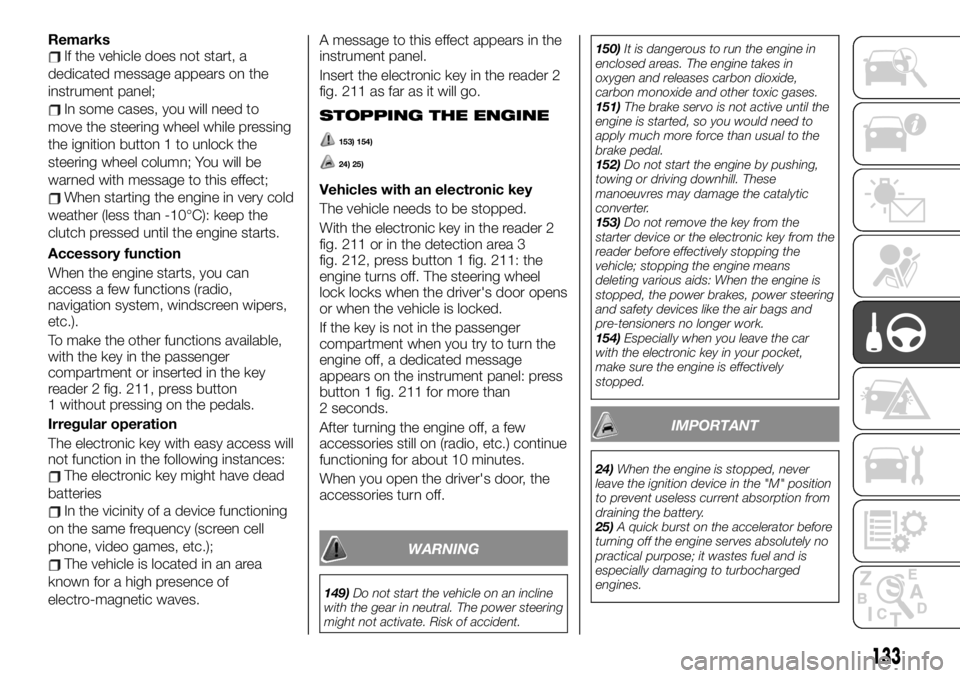
RemarksIf the vehicle does not start, a
dedicated message appears on the
instrument panel;
In some cases, you will need to
move the steering wheel while pressing
the ignition button 1 to unlock the
steering wheel column; You will be
warned with message to this effect;
When starting the engine in very cold
weather (less than -10°C): keep the
clutch pressed until the engine starts.
Accessory function
When the engine starts, you can
access a few functions (radio,
navigation system, windscreen wipers,
etc.).
To make the other functions available,
with the key in the passenger
compartment or inserted in the key
reader 2 fig. 211, press button
1 without pressing on the pedals.
Irregular operation
The electronic key with easy access will
not function in the following instances:
The electronic key might have dead
batteries
In the vicinity of a device functioning
on the same frequency (screen cell
phone, video games, etc.);
The vehicle is located in an area
known for a high presence of
electro-magnetic waves.A message to this effect appears in the
instrument panel.
Insert the electronic key in the reader 2
fig. 211 as far as it will go.
STOPPING THE ENGINE
153) 154)
24) 25)
Vehicles with an electronic key
The vehicle needs to be stopped.
With the electronic key in the reader 2
fig. 211 or in the detection area 3
fig. 212, press button 1 fig. 211: the
engine turns off. The steering wheel
lock locks when the driver's door opens
or when the vehicle is locked.
If the key is not in the passenger
compartment when you try to turn the
engine off, a dedicated message
appears on the instrument panel: press
button 1 fig. 211 for more than
2 seconds.
After turning the engine off, a few
accessories still on (radio, etc.) continue
functioning for about 10 minutes.
When you open the driver's door, the
accessories turn off.
WARNING
149)Do not start the vehicle on an incline
with the gear in neutral. The power steering
might not activate. Risk of accident.150)It is dangerous to run the engine in
enclosed areas. The engine takes in
oxygen and releases carbon dioxide,
carbon monoxide and other toxic gases.
151)The brake servo is not active until the
engine is started, so you would need to
apply much more force than usual to the
brake pedal.
152)Do not start the engine by pushing,
towing or driving downhill. These
manoeuvres may damage the catalytic
converter.
153)Do not remove the key from the
starter device or the electronic key from the
reader before effectively stopping the
vehicle; stopping the engine means
deleting various aids: When the engine is
stopped, the power brakes, power steering
and safety devices like the air bags and
pre-tensioners no longer work.
154)Especially when you leave the car
with the electronic key in your pocket,
make sure the engine is effectively
stopped.
IMPORTANT
24)When the engine is stopped, never
leave the ignition device in the "M" position
to prevent useless current absorption from
draining the battery.
25)A quick burst on the accelerator before
turning off the engine serves absolutely no
practical purpose; it wastes fuel and is
especially damaging to turbocharged
engines.
133
Page 141 of 236
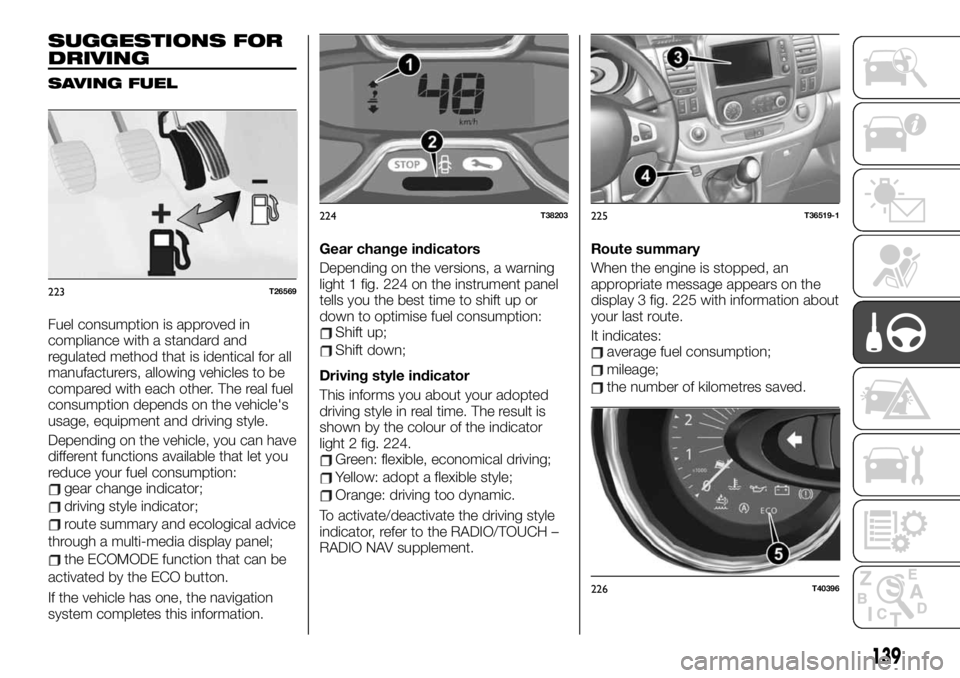
SUGGESTIONS FOR
DRIVING
SAVING FUEL
Fuel consumption is approved in
compliance with a standard and
regulated method that is identical for all
manufacturers, allowing vehicles to be
compared with each other. The real fuel
consumption depends on the vehicle's
usage, equipment and driving style.
Depending on the vehicle, you can have
different functions available that let you
reduce your fuel consumption:
gear change indicator;
driving style indicator;
route summary and ecological advice
through a multi-media display panel;
the ECOMODE function that can be
activated by the ECO button.
If the vehicle has one, the navigation
system completes this information.Gear change indicators
Depending on the versions, a warning
light 1 fig. 224 on the instrument panel
tells you the best time to shift up or
down to optimise fuel consumption:
Shift up;
Shift down;
Driving style indicator
This informs you about your adopted
driving style in real time. The result is
shown by the colour of the indicator
light 2 fig. 224.
Green: flexible, economical driving;
Yellow: adopt a flexible style;
Orange: driving too dynamic.
To activate/deactivate the driving style
indicator, refer to the RADIO/TOUCH –
RADIO NAV supplement.Route summary
When the engine is stopped, an
appropriate message appears on the
display 3 fig. 225 with information about
your last route.
It indicates:
average fuel consumption;
mileage;
the number of kilometres saved.
223T26569
224T38203225T36519-1
226T40396
139
Page 142 of 236

A general grade from 0 to 100 appears
that allows you to assess your
ecological driving performance: high
values mean reduced fuel consumption.
Below is some ecological advice to
improve your performance. Store your
preferred routes lets you compare
performances. For further information,
refer to the RADIO/TOUCH – RADIO
NAV supplement.
ECOMODE
ECOMODE is a function that optimises
fuel consumption. It acts on a few of
the vehicle's uses (heating, air
conditioning, power steering, etc.) and
on a few driving operations
(acceleration, gear shift, speed
regulation, deceleration, etc.).
Activation of the function
Press button 4 fig. 225.
TheECOfig. 226 indicator light 5 on
the instrument panel turns on to
confirm that it has been activated.
While driving, you can temporarily leave
the ECOMODE function to reset all
engine performances.
To do this, press the accelerator pedal
firmly.
The ECOMODE function is reactivated
as soon as you release the accelerator.
Deactivating the function
Press button 4 fig. 225.
TheECOfig. 226 warning light 5 on the
instrument panel turns off to confirm
that it has been deactivated.BehaviourRather than heat the engine while
stopped, we advise you to drive
moderately until the engine reaches its
normal operating temperature.
Speed increases fuel consumption.
Do not strain the engine by
exceeding speed in intermediary gears.
Use the highest gear.
Avoid sudden acceleration.
Brake as little as possible. By
assessing the danger or curve in
advance, it will be sufficient to lift your
foot off the accelerator.
When going uphill, we advise you to
keep a steady speed, without having to
change it.
In modern vehicles, double clutching
before stopping the engine is not
necessary and could even cause
damage.Tyres fig. 227
Pressure too low can increase fuel
consumption.
Using unsuitable tyres can increase
fuel consumption.
Advice for use
Favour the ECOMODE function.
Electricity increases fuel
consumption. We advise you to turn off
accessories when they are not in use.
You must use your lights according to
the laws in effect in the country you are
in.
Use diffusers as much as possible.
Driving at 100 km/h with the windows
open increases fuel consumption by
4% fig. 228.
For vehicles with climate control, fuel
consumption is increased (especially in
cities) when in use. For vehicles with
manual climate control, turn off the
system when you no longer need it.
227T26528
228T31077
140
STARTING AND DRIVING
Page 143 of 236
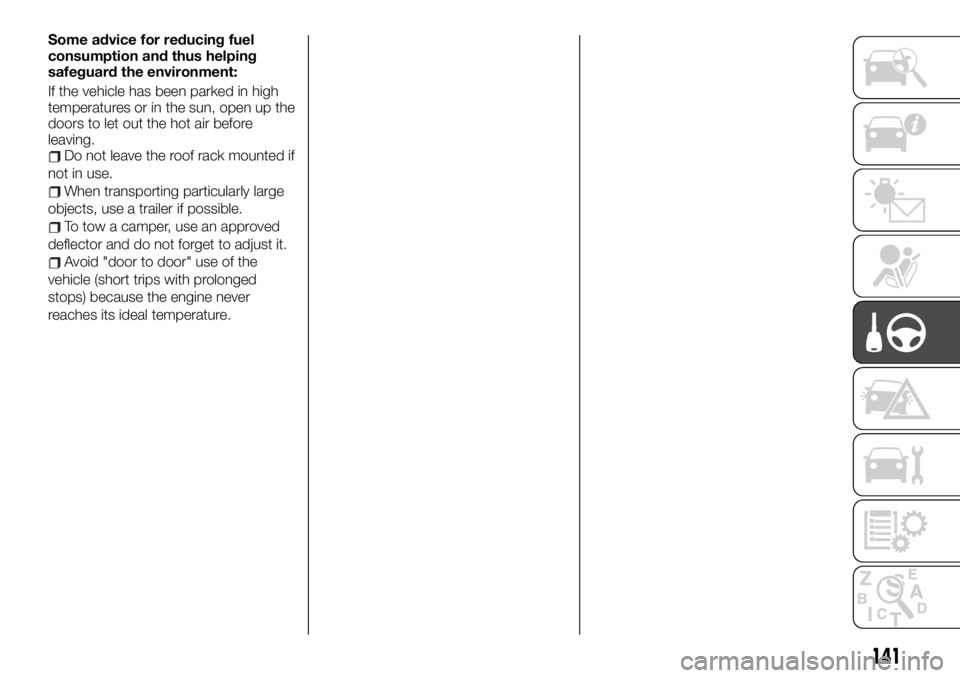
Some advice for reducing fuel
consumption and thus helping
safeguard the environment:
If the vehicle has been parked in high
temperatures or in the sun, open up the
doors to let out the hot air before
leaving.
Do not leave the roof rack mounted if
not in use.
When transporting particularly large
objects, use a trailer if possible.
To tow a camper, use an approved
deflector and do not forget to adjust it.
Avoid "door to door" use of the
vehicle (short trips with prolonged
stops) because the engine never
reaches its ideal temperature.
141
Page 160 of 236
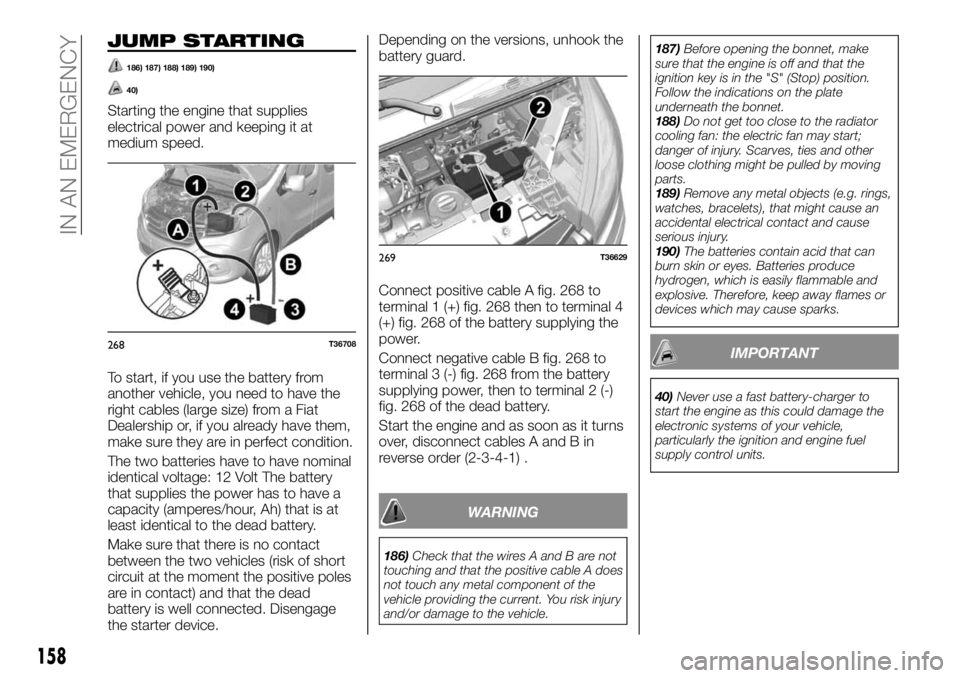
JUMP STARTING
186) 187) 188) 189) 190)
40)
Starting the engine that supplies
electrical power and keeping it at
medium speed.
To start, if you use the battery from
another vehicle, you need to have the
right cables (large size) from a Fiat
Dealership or, if you already have them,
make sure they are in perfect condition.
The two batteries have to have nominal
identical voltage: 12 Volt The battery
that supplies the power has to have a
capacity (amperes/hour, Ah) that is at
least identical to the dead battery.
Make sure that there is no contact
between the two vehicles (risk of short
circuit at the moment the positive poles
are in contact) and that the dead
battery is well connected. Disengage
the starter device.Depending on the versions, unhook the
battery guard.
Connect positive cable A fig. 268 to
terminal 1 (+) fig. 268 then to terminal 4
(+) fig. 268 of the battery supplying the
power.
Connect negative cable B fig. 268 to
terminal 3 (-) fig. 268 from the battery
supplying power, then to terminal 2 (-)
fig. 268 of the dead battery.
Start the engine and as soon as it turns
over, disconnect cables A and B in
reverse order (2-3-4-1) .
WARNING
186)Check that the wires A and B are not
touching and that the positive cable A does
not touch any metal component of the
vehicle providing the current. You risk injury
and/or damage to the vehicle.187)Before opening the bonnet, make
sure that the engine is off and that the
ignition key is in the "S" (Stop) position.
Follow the indications on the plate
underneath the bonnet.
188)Do not get too close to the radiator
cooling fan: the electric fan may start;
danger of injury. Scarves, ties and other
loose clothing might be pulled by moving
parts.
189)Remove any metal objects (e.g. rings,
watches, bracelets), that might cause an
accidental electrical contact and cause
serious injury.
190)The batteries contain acid that can
burn skin or eyes. Batteries produce
hydrogen, which is easily flammable and
explosive. Therefore, keep away flames or
devices which may cause sparks.
IMPORTANT
40)Never use a fast battery-charger to
start the engine as this could damage the
electronic systems of your vehicle,
particularly the ignition and engine fuel
supply control units.
268T36708
269T36629
158
IN AN EMERGENCY